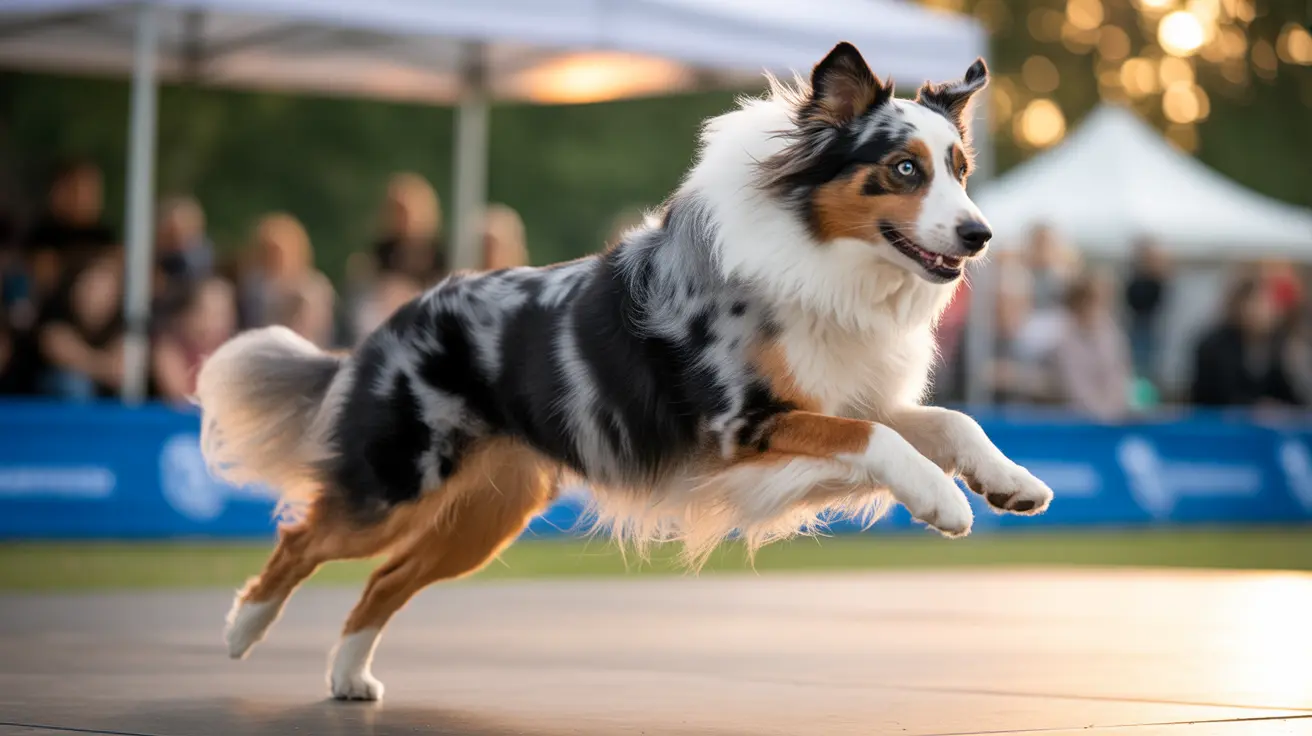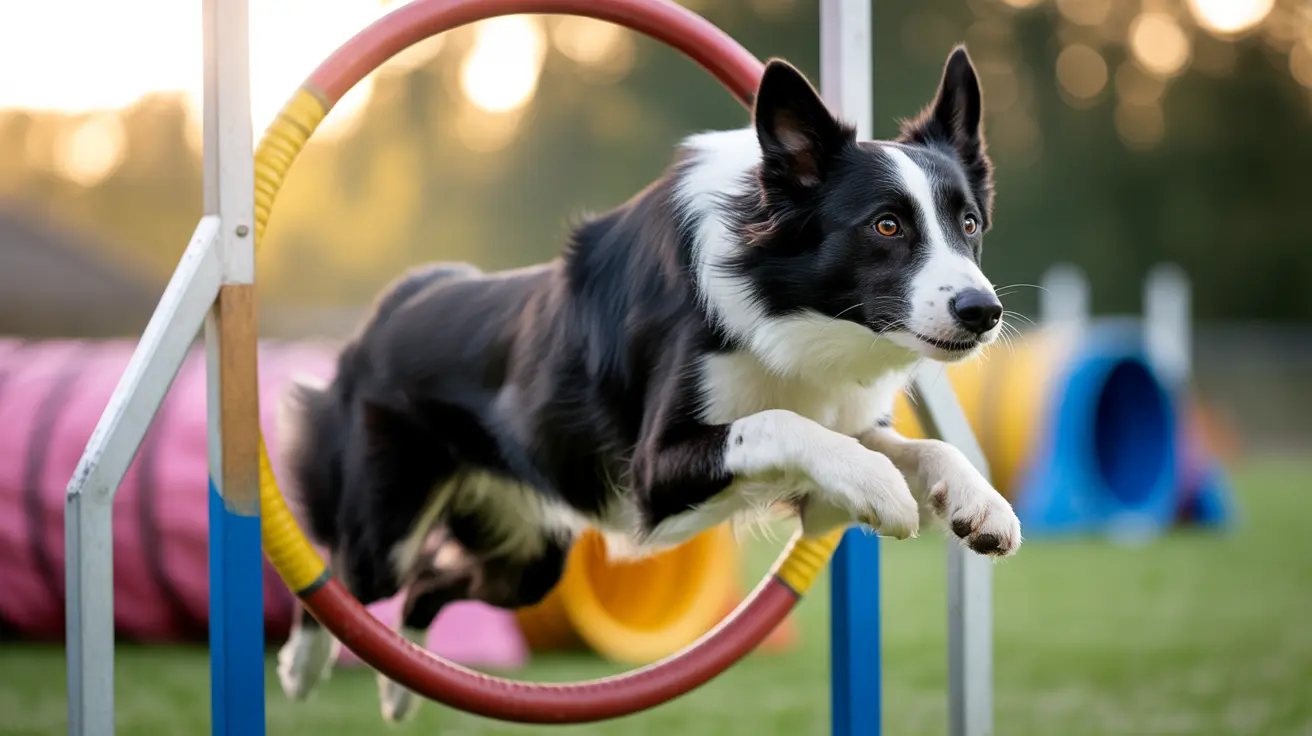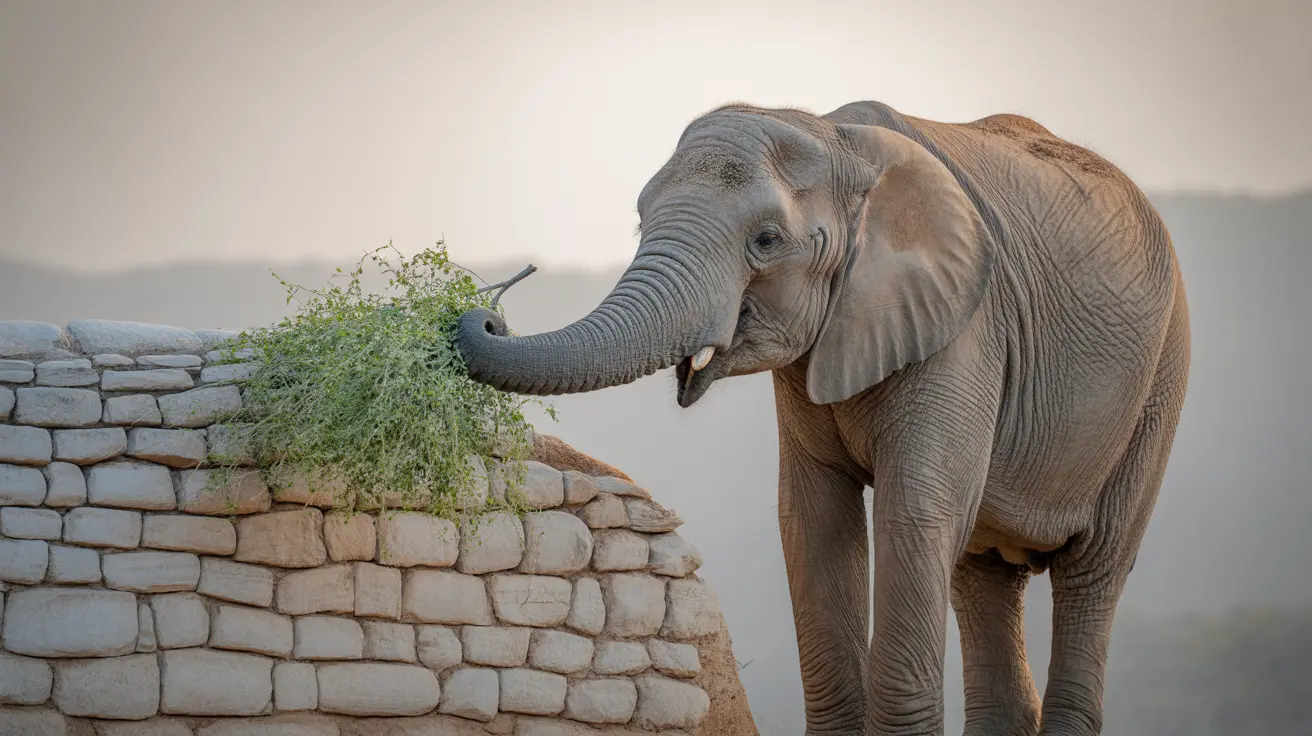Dog Dancing Fitness Benefits: How This Unique Sport Enhances Your Dog's Health and Strengthens Your Bond
Dog dancing, also known as musical freestyle, has emerged as one of the most captivating and beneficial canine sports available today. This innovative activity combines choreographed movements, obedience training, and musical expression to create an engaging experience that offers remarkable fitness benefits for dogs while deepening the bond between pets and their owners. As more dog owners discover the transformative power of this sport, veterinarians and animal behaviorists are recognizing dog dancing fitness benefits as a comprehensive approach to canine wellness that addresses both physical and mental health needs.
Unlike traditional dog exercises that focus solely on physical exertion, dog dancing provides a holistic approach to canine fitness that engages multiple aspects of your dog's development. The sport has evolved significantly since its modern inception in the late 1980s, with roots tracing back to ancient civilizations where dogs and humans performed together. Today, organizations like the World Canine Freestyle Organization and Dogdance International e.V. promote standardized practices that prioritize dog welfare while maximizing the health benefits of this unique activity.
Whether you're a seasoned dog owner looking for new ways to engage with your pet or a newcomer curious about alternative fitness activities for your canine companion, understanding the comprehensive benefits of dog dancing can help you make informed decisions about your dog's exercise routine. This sport offers something truly special: a way to achieve optimal fitness while building an unbreakable partnership through the joy of movement and music.
What Is Dog Dancing and How Does It Work?
Dog dancing, officially known as musical freestyle, is a choreographed activity where dogs and their handlers perform synchronized routines to music. This sport combines elements of obedience training, trick performance, and artistic expression to create engaging performances that typically last 2-4 minutes. The activity encompasses two main categories: Heelwork to Music (HTM), which requires dogs to maintain specific foot positions within two feet of their handler, and Freestyle (FS), which allows for more creative expression including jumps, spins, weaving through legs, and the use of props.
The foundation of dog dancing lies in basic obedience training, where dogs learn to respond to their handler's cues and maintain focus throughout the routine. Handlers gradually introduce musical elements, teaching their dogs to move in rhythm with carefully selected songs that match their pet's natural movement patterns and energy levels. The training process involves building a repertoire of individual movements and then chaining these behaviors together to create fluid, synchronized sequences that tell a story or express a theme through movement.
What makes dog dancing particularly special is its accessibility and adaptability. Any breed, age, or ability level can participate in this sport, as routines are specifically tailored to each dog's physical capabilities and temperament. Dogs with special needs, including seniors or those with disabilities, can successfully participate in adapted classes that accommodate their limitations while still providing substantial fitness benefits and mental stimulation.
Physical Fitness Benefits of Dog Dancing
The physical fitness advantages of dog dancing are extensive and multifaceted, making it one of the most comprehensive exercise options available for dogs. Unlike repetitive activities like running or fetch, dog dancing engages multiple muscle groups through varied movements that promote balanced development throughout the body. The sport particularly excels at promoting joint health through controlled, low-impact movements that maintain flexibility and range of motion without placing excessive stress on the skeletal system.
Cardiovascular fitness receives significant benefits through the sustained activity periods required in dog dancing routines. The continuous movement patterns, combined with the mental focus required to follow cues and maintain synchronization, create an optimal cardiovascular workout that builds endurance gradually over time. This sustained aerobic activity helps maintain healthy weight, improves circulation, and strengthens the heart muscle, contributing to overall longevity and vitality.
The sport also provides exceptional benefits for muscle tone and coordination development. Dogs learn to perform precise movements such as turns, spins, backing up, and various gait changes that require core strength and proprioceptive awareness. These movements help develop balance, spatial awareness, and fine motor control that extends beyond the dance routine to improve overall athletic performance and reduce injury risk in daily activities.
Joint Health and Flexibility
One of the most significant dog dancing fitness benefits is the improvement in joint health and flexibility. The controlled movements required in routines help maintain and improve range of motion in all major joints, from the neck and spine to the hips and shoulders. Unlike high-impact activities that can stress joints, dog dancing emphasizes smooth, controlled movements that lubricate joints naturally and promote healthy cartilage maintenance.
The variety of movements incorporated in dog dancing routines ensures that joints move through their full range of motion regularly, preventing stiffness and maintaining flexibility as dogs age. This is particularly beneficial for breeds prone to joint issues, as the gentle nature of the exercise provides therapeutic benefits while building supporting muscle strength around vulnerable areas.
Mental Stimulation and Cognitive Benefits
The cognitive demands of dog dancing provide exceptional mental stimulation that goes far beyond traditional exercise routines. Dogs must learn to process complex sequences of movements, respond to subtle cues from their handlers, and maintain focus throughout extended training sessions and performances. This mental engagement activates neural pathways that promote cognitive health and can help prevent age-related mental decline.
Learning and remembering choreographed sequences challenges dogs' memory capabilities and problem-solving skills. The process of associating specific movements with musical cues or handler signals requires dogs to make complex cognitive connections that strengthen neural networks. This mental workout is particularly beneficial for intelligent breeds that may become destructive or anxious without adequate mental stimulation.
The combination of physical activity with mental challenges creates an ideal environment for neuroplasticity, the brain's ability to form new connections and adapt throughout life. Regular participation in dog dancing can improve learning capacity, enhance focus and attention span, and contribute to overall cognitive wellness that extends into all areas of a dog's life.
Strengthening the Human-Animal Bond
Perhaps one of the most profound dog dancing fitness benefits is the strengthening of the relationship between dogs and their handlers. The sport requires intense cooperation, communication, and mutual trust that develops through consistent training and practice. This partnership extends far beyond the dance floor, creating a deeper understanding and connection that enhances all aspects of the human-animal relationship.
The training process necessitates clear communication between handler and dog, requiring owners to become more attuned to their pet's body language, stress signals, and learning style. This heightened awareness creates a stronger bond based on mutual respect and understanding. Dogs learn to trust their handlers completely, following their lead through complex routines and responding to subtle cues that demonstrate the deep connection they've developed.
The positive reinforcement training methods used in dog dancing strengthen the emotional bond through shared achievement and celebration. As dogs master new movements and complete routines successfully, both handler and dog experience the joy of accomplishment together. This shared success creates positive associations that strengthen the relationship and increase mutual motivation to continue learning and growing together.
Building Trust Through Training
The process of teaching dog dancing routines requires patience, consistency, and positive reinforcement that builds trust gradually over time. Dogs learn to rely on their handlers for guidance and support, developing confidence in their ability to perform new and challenging movements. This trust-building process creates a foundation of security that extends beyond training sessions into all aspects of the relationship.
Handlers must also learn to trust their dogs' capabilities and respect their limitations, creating a balanced partnership based on mutual respect. This two-way trust development is essential for successful dog dancing and creates a relationship dynamic that benefits both parties in all aspects of their shared life.
Getting Started with Dog Dancing
Beginning your dog dancing journey requires no prior experience in dance or advanced dog training, making it accessible to handlers of all skill levels. The key to success lies in building a solid foundation of basic obedience and gradually introducing musical elements and choreographed movements. Start with simple movements that your dog already knows, such as sit, stay, and heel, before progressing to more complex tricks and transitions.
The first step involves establishing a strong relationship with your dog based on positive reinforcement and clear communication. Use treats, praise, and play to reward desired behaviors, ensuring that training sessions remain enjoyable and stress-free for your pet. Begin with short training periods of 5-10 minutes to maintain your dog's attention and prevent fatigue, gradually increasing session length as your dog's focus and endurance improve.
Music selection plays a crucial role in successful dog dancing, with the tempo and style needing to match your dog's natural movement patterns and energy level. Choose songs with clear beats and consistent rhythm that allow you to synchronize movements effectively. Many handlers find success starting with slower tempo music and gradually progressing to more complex rhythms as their dog becomes comfortable with the basic concepts of moving to music.
Essential Training Techniques
Successful dog dancing training relies on classical conditioning and positive reinforcement methods that make learning enjoyable for dogs. Break down complex movements into small, achievable steps that allow your dog to experience success frequently. This approach builds confidence and maintains motivation throughout the learning process.
Practice in various environments to help your dog generalize their training and reduce stress during performances or competitions. Training in different locations with varying noise levels and distractions helps dogs maintain focus and perform consistently regardless of the environment. This preparation is particularly important for dogs who may eventually participate in competitions where unfamiliar sounds and surroundings can be overwhelming.
Adaptations for Dogs with Special Needs
One of the most remarkable aspects of dog dancing is its adaptability for dogs with physical limitations or special needs. The sport can be successfully modified to accommodate deaf dogs, senior dogs with mobility issues, and pets with various physical challenges. These adaptations ensure that all dogs can experience the fitness benefits and joy of participating in this engaging activity.
For deaf dogs, handlers can use visual cues and vibrations through the floor to communicate musical timing and movement cues. Hand signals replace verbal commands, and the focus shifts to visual synchronization rather than auditory cues. Many deaf dogs excel in dog dancing because they naturally rely more heavily on visual communication and body language from their handlers.
Senior dogs benefit from modified routines that emphasize gentle movements and shorter sequences while still providing mental stimulation and light physical exercise. Movements can be adapted to accommodate arthritis or joint stiffness, focusing on maintaining flexibility and mobility rather than athletic performance. These modifications ensure that older dogs continue to experience the cognitive and emotional benefits of the sport while respecting their physical limitations.
Comparing Dog Dancing to Other Canine Sports
While dog dancing offers unique benefits, it's helpful to understand how it compares to other popular canine sports and activities. Agility training provides excellent physical exercise and mental challenges but may be too intense for some dogs or those with physical limitations. Dog dancing offers a gentler alternative that still provides comprehensive fitness benefits while being more accessible to dogs of all ages and abilities.
Scent work activities excel at providing mental stimulation through the dog's natural hunting instincts but may not provide the same level of physical exercise as dog dancing. The combination of mental and physical challenges in dog dancing creates a more balanced approach to canine wellness that addresses both aspects simultaneously.
Traditional obedience training focuses primarily on behavioral improvement and basic commands, while dog dancing expands these foundations into creative expression and advanced skill development. The artistic elements of dog dancing provide additional mental stimulation and emotional satisfaction that goes beyond basic obedience work, creating a more engaging and enriching experience for both dog and handler.
Safety Considerations and Best Practices
Ensuring safety during dog dancing training and performances is paramount to maximizing the sport's benefits while preventing injuries. Handlers must carefully assess their dog's physical capabilities and limitations, avoiding movements that could strain joints or cause injury. Regular veterinary checkups help identify potential issues before they become problems and ensure that participation remains beneficial rather than harmful.
Proper warm-up and cool-down routines are essential for preventing muscle strain and joint injury. Begin each training session with gentle movements and gradually progress to more complex routines, allowing your dog's body to adjust to the physical demands. Similarly, end sessions with relaxed movements and stretching to promote recovery and prevent stiffness.
Monitor your dog closely for signs of fatigue, stress, or discomfort during training and performances. Dogs should appear happy and engaged throughout the activity, with tail wagging and enthusiastic participation indicating positive engagement. Any signs of reluctance, excessive panting, or behavioral changes should prompt immediate assessment and potential modification of the routine or training approach.
Recognizing Limitations and Avoiding Overexertion
Understanding your dog's individual limitations is crucial for safe participation in dog dancing. Some breeds may be more prone to respiratory issues and require modifications to accommodate their breathing patterns, while others may have joint vulnerabilities that need special consideration. Working within these natural limitations ensures that the activity remains beneficial and enjoyable rather than stressful or harmful.
Avoid pushing dogs beyond their comfortable limits in pursuit of perfect performances. The goal of dog dancing should always be mutual enjoyment and fitness benefits rather than competitive achievement at the expense of the dog's wellbeing. Respect your dog's pace of learning and physical capabilities, allowing for individual variation in progress and performance standards.
Frequently Asked Questions
- What age can dogs start learning dog dancing? Dogs can begin learning basic dog dancing movements as early as 6 months old, once they've mastered basic obedience commands. However, complex jumping or spinning movements should be delayed until growth plates close, typically around 12-18 months depending on the breed. Puppies can focus on simple movements like heelwork and basic tricks that don't stress developing joints.
- How often should I practice dog dancing with my dog? Most experts recommend short, frequent training sessions of 5-15 minutes, practiced 3-4 times per week. This frequency provides consistency for learning while preventing fatigue and maintaining your dog's enthusiasm. As your dog becomes more experienced, sessions can be longer but should never exceed 30 minutes to avoid mental and physical exhaustion.
- Can senior dogs participate in dog dancing? Yes, senior dogs can absolutely participate in modified dog dancing routines that accommodate their physical limitations. Focus on gentle movements, shorter sequences, and exercises that promote flexibility and mental stimulation without straining aging joints. Many senior dogs thrive in adapted dog dancing programs that provide social interaction and cognitive engagement.
- What equipment do I need to start dog dancing? The basic equipment needed for dog dancing is minimal: a well-fitting collar or harness, high-value treats for training, and access to music. Optional equipment includes props like scarves or lightweight objects, but these aren't necessary for beginners. A safe, non-slip surface for practice is important to prevent injuries during training sessions.
- How do I know if my dog enjoys dog dancing? Signs that your dog enjoys dog dancing include enthusiastic participation, tail wagging during training, eagerness to begin sessions, and relaxed body language throughout the activity. Dogs who enjoy the sport typically show excitement when they see training props or hear their routine music. If your dog shows reluctance, stress signals, or tries to leave the training area, reassess your approach or consider whether the activity is suitable for your pet.
- Can dog dancing help with behavioral problems? Dog dancing can help address certain behavioral issues by providing mental stimulation, physical exercise, and strengthening the bond between dog and handler. The structured training and positive reinforcement can improve focus, reduce excess energy that leads to destructive behaviors, and build confidence in nervous dogs. However, serious behavioral problems may require professional training in addition to dog dancing activities.
- Is dog dancing suitable for all dog breeds? Yes, dog dancing can be adapted for all breeds, though routines should be tailored to each dog's physical characteristics and natural movement patterns. Brachycephalic breeds may need modifications to prevent breathing difficulties, while breeds with back problems might avoid certain twisting movements. The key is working within each dog's natural abilities rather than forcing movements that don't suit their body type.
Conclusion
Dog dancing fitness benefits extend far beyond simple physical exercise, offering a comprehensive approach to canine wellness that addresses physical health, mental stimulation, and emotional bonding simultaneously. This unique sport provides an accessible, adaptable activity that can enhance the lives of dogs and their owners regardless of age, breed, or experience level. The combination of cardiovascular exercise, joint mobility, cognitive challenges, and relationship building creates an ideal environment for promoting overall canine health and happiness.
As more pet owners discover the transformative power of dog dancing, the sport continues to evolve and expand, offering new opportunities for dogs and handlers to connect through movement and music. Whether you're seeking a gentle fitness activity for a senior dog, an engaging challenge for an intelligent breed, or simply a new way to deepen your bond with your canine companion, dog dancing provides a rewarding path toward enhanced wellness and mutual enjoyment. The investment in learning this beautiful sport pays dividends in improved health, strengthened relationships, and countless moments of shared joy that will enrich both your life and your dog's for years to come.






